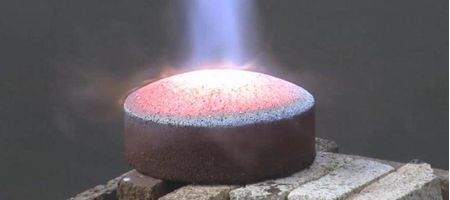NASA scientists will next week test whether a heat shield made from the soil of the moon, Mars or an asteroid could stand up to a plunge through Earth’s atmosphere.

If so, it could mean that spacecraft could in future leave Earth without a heavy heat shield, instead making one on the surface of another world.
The weight saving could allow the use of smaller rockets, or the ability to carry more supplies.
Over the last few months, a team of engineers has been trying out various mixtures and techniques to find out whether the idea has any potential. So far, the tests have been very successful, with small bricks of material standing up well to the intense heat of a blowtorch.
A sensor placed behind the brick recorded temperatures of about 200 degrees F compared to the approximately 4000 degrees F the front side endured.
“I expected some to fail,” says NASA researcher Michael Hogue, who came up with the idea. “There is an optimum range of density you need to hit for each material where it’s light enough to have low enough thermal conductivity, but also structurally strong enough to survive the forces of atmospheric entry. All of our formulations that we tested with a cutting torch at least passed that.”
But the dome-shaped bricks, each two inches thick and four inches in diameter and made of different combinations of material, will next week face a much tougher test, when they’re placed inside the arc jet facility at NASA’s Ames Research Center in California.
There, they will be subjected to a scorching plasma stream that will put them through heating conditions similar to those seen in during entry.
“That will ultimately determine whether this idea is feasible or not,” Hogue said.
Making the heat shield in space would likely be the work of a robotic device – or at least a heavily automated system – either mixing the regolith with a rubbery substance in a mold or heating a large disc of regolith until the soil elements fuse together. The heat shield could then be cut and shaped as needed.
The primary advantage is that getting the finished heat shield off an asteroid or Martian moon would take very little force because the gravity is so low.
The heat shield wouldn’t be reusable, but would be designed to have some layers fleck or burn off, a process called ablating. All heat shields except the space shuttles’ were made of ablative material.
“You can make it massive and if it heats up and ablates off, all the better because the ablated mass takes heat with it.” Hogue said. “After about five minutes you jettison the shield over water and you’re done.”






